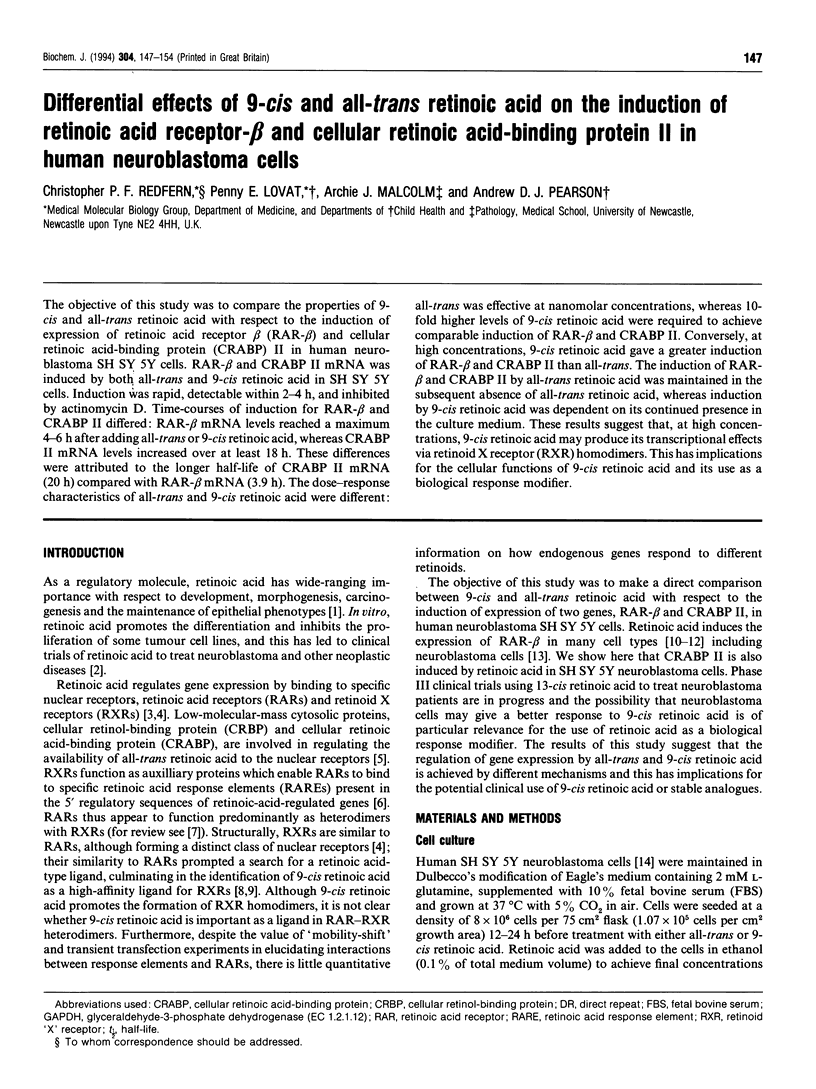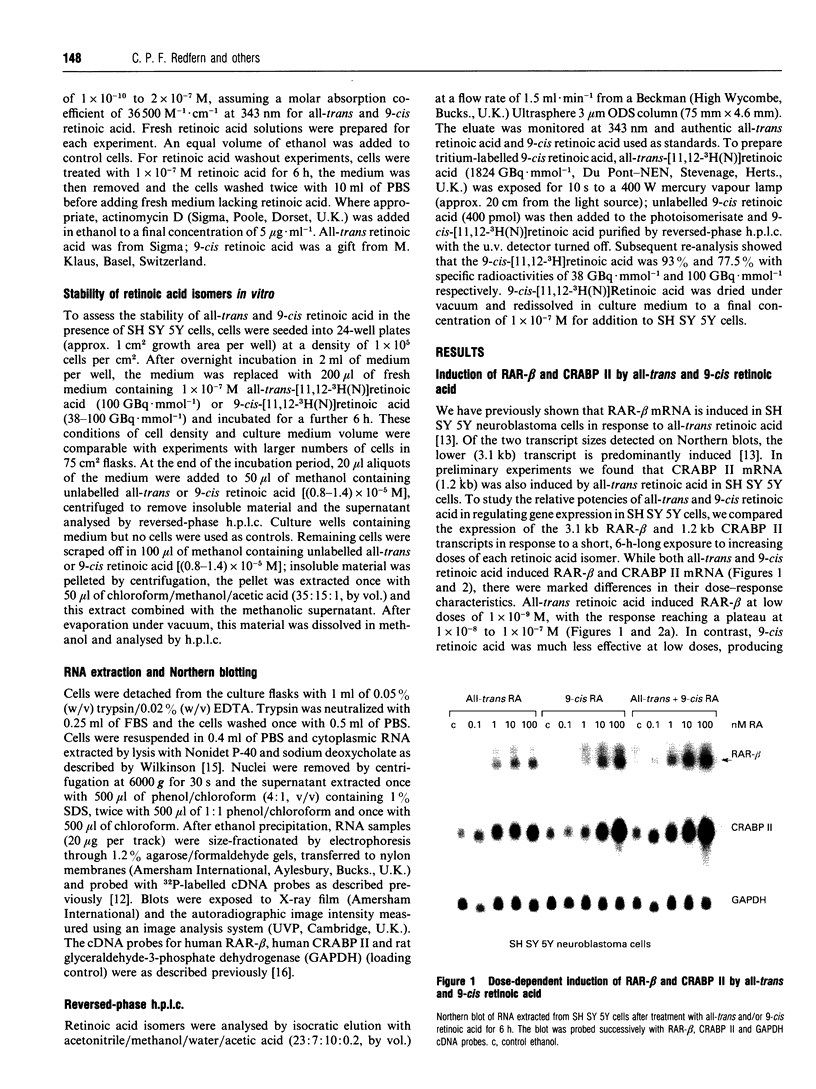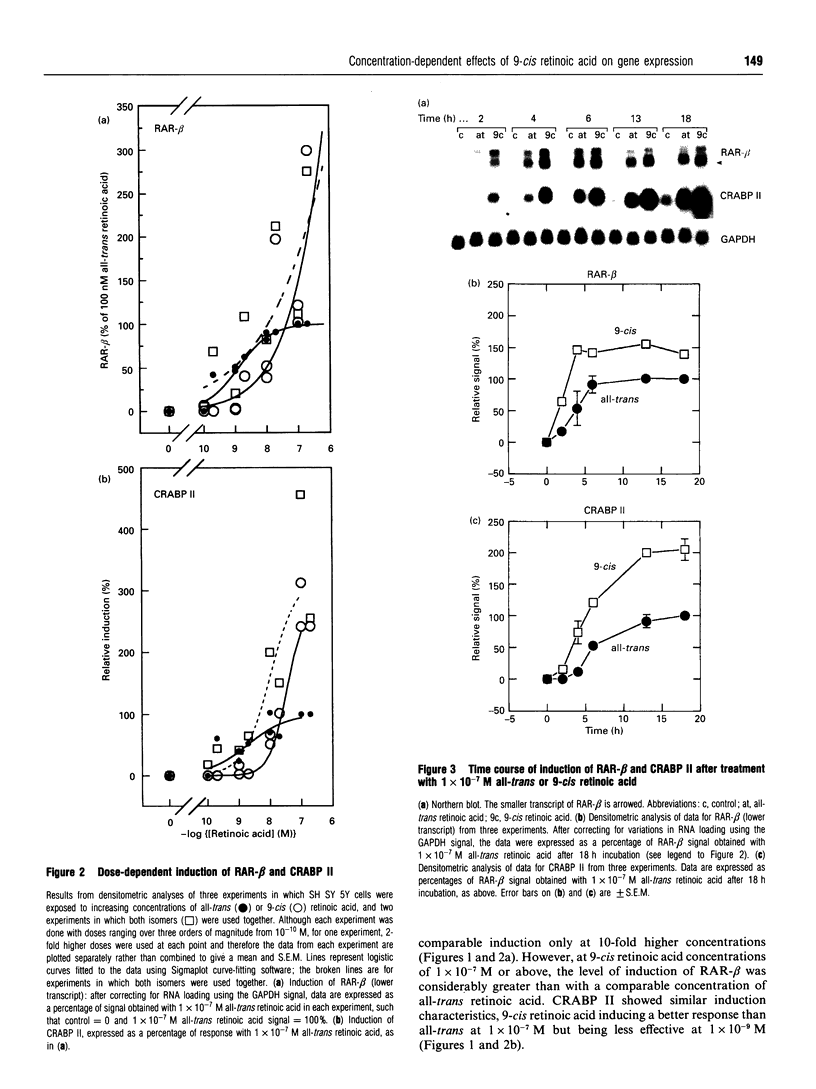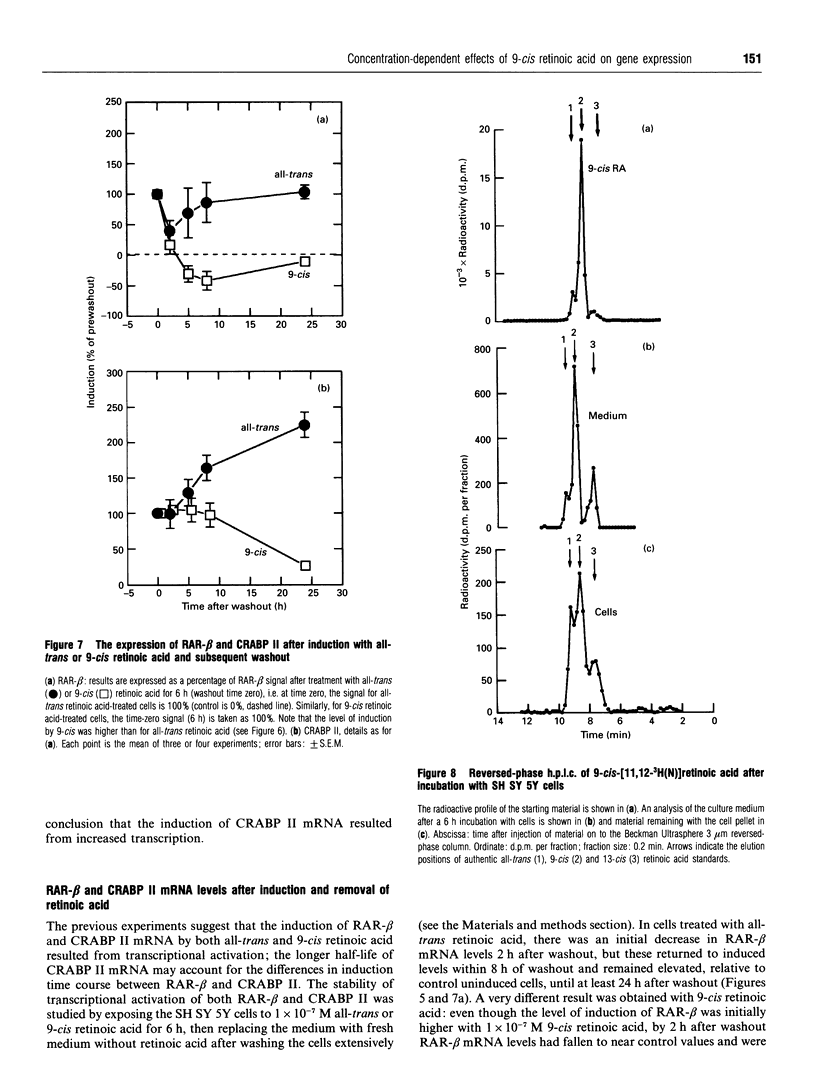Abstract
The objective of this study was to compare the properties of 9-cis and all-trans retinoic acid with respect to the induction of expression of retinoic acid receptor beta (RAR-beta) and cellular retinoic acid-binding protein (CRABP) II in human neuroblastoma SH SY 5Y cells. RAR-beta and CRABP II mRNA was induced by both all-trans and 9-cis retinoic acid in SH SY 5Y cells. Induction was rapid, detectable within 2-4 h, and inhibited by actinomycin D. Time-courses of induction for RAR-beta and CRABP II differed: RAR-beta mRNA levels reached a maximum 4-6 h after adding all-trans or 9-cis retinoic acid, whereas CRABP II mRNA levels increased over at least 18 h. These differences were attributed to the longer half-life of CRABP II mRNA (20 h) compared with RAR-beta mRNA (3.9 h). The dose-response characteristics of all-trans and 9-cis retinoic acid were different: all-trans was effective at nanomolar concentrations, whereas 10-fold higher levels of 9-cis retinoic acid were required to achieve comparable induction of RAR-beta and CRABP II. Conversely, at high concentrations, 9-cis retinoic acid gave a greater induction of RAR-beta and CRABP II than all-trans. The induction of RAR-beta and CRABP II by all-trans retinoic acid was maintained in the subsequent absence of all-trans retinoic acid, whereas induction by 9-cis retinoic acid was dependent on its continued presence in the culture medium. These results suggest that, at high concentrations, 9-cis retinoic acid may produce its transcriptional effects via retinoid X receptor (RXR) homodimers. This has implications for the cellular functions of 9-cis retinoic acid and its use as a biological response modifier.
Full text
PDF







Images in this article
Selected References
These references are in PubMed. This may not be the complete list of references from this article.
- Allegretto E. A., McClurg M. R., Lazarchik S. B., Clemm D. L., Kerner S. A., Elgort M. G., Boehm M. F., White S. K., Pike J. W., Heyman R. A. Transactivation properties of retinoic acid and retinoid X receptors in mammalian cells and yeast. Correlation with hormone binding and effects of metabolism. J Biol Chem. 1993 Dec 15;268(35):26625–26633. [PubMed] [Google Scholar]
- Allenby G., Bocquel M. T., Saunders M., Kazmer S., Speck J., Rosenberger M., Lovey A., Kastner P., Grippo J. F., Chambon P. Retinoic acid receptors and retinoid X receptors: interactions with endogenous retinoic acids. Proc Natl Acad Sci U S A. 1993 Jan 1;90(1):30–34. doi: 10.1073/pnas.90.1.30. [DOI] [PMC free article] [PubMed] [Google Scholar]
- Aström A., Pettersson U., Voorhees J. J. Structure of the human cellular retinoic acid-binding protein II gene. Early transcriptional regulation by retinoic acid. J Biol Chem. 1992 Dec 15;267(35):25251–25255. [PubMed] [Google Scholar]
- Boylan J. F., Gudas L. J. Overexpression of the cellular retinoic acid binding protein-I (CRABP-I) results in a reduction in differentiation-specific gene expression in F9 teratocarcinoma cells. J Cell Biol. 1991 Mar;112(5):965–979. doi: 10.1083/jcb.112.5.965. [DOI] [PMC free article] [PubMed] [Google Scholar]
- Carlberg C., Saurat J. H., Siegenthaler G. 9-cis-retinoic acid is a natural antagonist for the retinoic acid receptor response pathway. Biochem J. 1993 Oct 15;295(Pt 2):343–346. doi: 10.1042/bj2950343. [DOI] [PMC free article] [PubMed] [Google Scholar]
- Clagett-Dame M., Verhalen T. J., Biedler J. L., Repa J. J. Identification and characterization of all-trans-retinoic acid receptor transcripts and receptor protein in human neuroblastoma cells. Arch Biochem Biophys. 1993 Feb 1;300(2):684–693. doi: 10.1006/abbi.1993.1095. [DOI] [PubMed] [Google Scholar]
- Curley R. W., Jr, Fowble J. W. Photoisomerization of retinoic acid and its photoprotection in physiologic-like solutions. Photochem Photobiol. 1988 Jun;47(6):831–835. doi: 10.1111/j.1751-1097.1988.tb01667.x. [DOI] [PubMed] [Google Scholar]
- Darmon M., Rocher M., Cavey M. T., Martin B., Rabilloud T., Delescluse C., Shroot B. Biological activity of retinoids correlates with affinity for nuclear receptors but not for cytosolic binding protein. Skin Pharmacol. 1988;1(3):161–175. doi: 10.1159/000210770. [DOI] [PubMed] [Google Scholar]
- Durand B., Saunders M., Leroy P., Leid M., Chambon P. All-trans and 9-cis retinoic acid induction of CRABPII transcription is mediated by RAR-RXR heterodimers bound to DR1 and DR2 repeated motifs. Cell. 1992 Oct 2;71(1):73–85. doi: 10.1016/0092-8674(92)90267-g. [DOI] [PubMed] [Google Scholar]
- Fiorella P. D., Napoli J. L. Expression of cellular retinoic acid binding protein (CRABP) in Escherichia coli. Characterization and evidence that holo-CRABP is a substrate in retinoic acid metabolism. J Biol Chem. 1991 Sep 5;266(25):16572–16579. [PubMed] [Google Scholar]
- Fogh K., Voorhees J. J., Aström A. Expression, purification, and binding properties of human cellular retinoic acid-binding protein type I and type II. Arch Biochem Biophys. 1993 Feb 1;300(2):751–755. doi: 10.1006/abbi.1993.1104. [DOI] [PubMed] [Google Scholar]
- Heyman R. A., Mangelsdorf D. J., Dyck J. A., Stein R. B., Eichele G., Evans R. M., Thaller C. 9-cis retinoic acid is a high affinity ligand for the retinoid X receptor. Cell. 1992 Jan 24;68(2):397–406. doi: 10.1016/0092-8674(92)90479-v. [DOI] [PubMed] [Google Scholar]
- Levin A. A., Sturzenbecker L. J., Kazmer S., Bosakowski T., Huselton C., Allenby G., Speck J., Kratzeisen C., Rosenberger M., Lovey A. 9-cis retinoic acid stereoisomer binds and activates the nuclear receptor RXR alpha. Nature. 1992 Jan 23;355(6358):359–361. doi: 10.1038/355359a0. [DOI] [PubMed] [Google Scholar]
- Lovat P. E., Pearson A. D., Malcolm A., Redfern C. P. Retinoic acid receptor expression during the in vitro differentiation of human neuroblastoma. Neurosci Lett. 1993 Nov 12;162(1-2):109–113. doi: 10.1016/0304-3940(93)90572-3. [DOI] [PubMed] [Google Scholar]
- MacDonald P. N., Dowd D. R., Nakajima S., Galligan M. A., Reeder M. C., Haussler C. A., Ozato K., Haussler M. R. Retinoid X receptors stimulate and 9-cis retinoic acid inhibits 1,25-dihydroxyvitamin D3-activated expression of the rat osteocalcin gene. Mol Cell Biol. 1993 Sep;13(9):5907–5917. doi: 10.1128/mcb.13.9.5907. [DOI] [PMC free article] [PubMed] [Google Scholar]
- Napoli J. L. Biosynthesis and metabolism of retinoic acid: roles of CRBP and CRABP in retinoic acid: roles of CRBP and CRABP in retinoic acid homeostasis. J Nutr. 1993 Feb;123(2 Suppl):362–366. doi: 10.1093/jn/123.suppl_2.362. [DOI] [PubMed] [Google Scholar]
- Redfern C. P., Daly A. K., Latham J. A., Todd C. The biological activity of retinoids in melanoma cells. Induction of expression of retinoic acid receptor-beta by retinoic acid in S91 melanoma cells. FEBS Lett. 1990 Oct 29;273(1-2):19–22. doi: 10.1016/0014-5793(90)81041-l. [DOI] [PubMed] [Google Scholar]
- Redfern C. P. Retinoic acid receptors. Pathobiology. 1992;60(5):254–263. doi: 10.1159/000163732. [DOI] [PubMed] [Google Scholar]
- Redfern C. P., Todd C. Retinoic acid receptor expression in human skin keratinocytes and dermal fibroblasts in vitro. J Cell Sci. 1992 May;102(Pt 1):113–121. doi: 10.1242/jcs.102.1.113. [DOI] [PubMed] [Google Scholar]
- Redfern C. P., Wilson K. E. Ligand binding properties of human cellular retinoic acid binding protein II expressed in E. coli as a glutathione-S-transferase fusion protein. FEBS Lett. 1993 Apr 26;321(2-3):163–168. doi: 10.1016/0014-5793(93)80100-9. [DOI] [PubMed] [Google Scholar]
- Ross R. A., Spengler B. A., Biedler J. L. Coordinate morphological and biochemical interconversion of human neuroblastoma cells. J Natl Cancer Inst. 1983 Oct;71(4):741–747. [PubMed] [Google Scholar]
- Siddiqui N. A., Loughney A., Thomas E. J., Dunlop W., Redfern C. P. Cellular retinoid binding proteins and nuclear retinoic acid receptors in endometrial epithelial cells. Hum Reprod. 1994 Aug;9(8):1410–1416. doi: 10.1093/oxfordjournals.humrep.a138720. [DOI] [PubMed] [Google Scholar]
- Smith M. A., Parkinson D. R., Cheson B. D., Friedman M. A. Retinoids in cancer therapy. J Clin Oncol. 1992 May;10(5):839–864. doi: 10.1200/JCO.1992.10.5.839. [DOI] [PubMed] [Google Scholar]
- Stunnenberg H. G. Mechanisms of transactivation by retinoic acid receptors. Bioessays. 1993 May;15(5):309–315. doi: 10.1002/bies.950150504. [DOI] [PubMed] [Google Scholar]
- Takase S., Ong D. E., Chytil F. Transfer of retinoic acid from its complex with cellular retinoic acid-binding protein to the nucleus. Arch Biochem Biophys. 1986 Jun;247(2):328–334. doi: 10.1016/0003-9861(86)90591-6. [DOI] [PubMed] [Google Scholar]
- Wilkinson M. RNA isolation: a mini-prep method. Nucleic Acids Res. 1988 Nov 25;16(22):10933–10933. doi: 10.1093/nar/16.22.10933. [DOI] [PMC free article] [PubMed] [Google Scholar]
- Yang Y., Vacchio M. S., Ashwell J. D. 9-cis-retinoic acid inhibits activation-driven T-cell apoptosis: implications for retinoid X receptor involvement in thymocyte development. Proc Natl Acad Sci U S A. 1993 Jul 1;90(13):6170–6174. doi: 10.1073/pnas.90.13.6170. [DOI] [PMC free article] [PubMed] [Google Scholar]
- Zhang X. K., Hoffmann B., Tran P. B., Graupner G., Pfahl M. Retinoid X receptor is an auxiliary protein for thyroid hormone and retinoic acid receptors. Nature. 1992 Jan 30;355(6359):441–446. doi: 10.1038/355441a0. [DOI] [PubMed] [Google Scholar]
- Zhang X. K., Lehmann J., Hoffmann B., Dawson M. I., Cameron J., Graupner G., Hermann T., Tran P., Pfahl M. Homodimer formation of retinoid X receptor induced by 9-cis retinoic acid. Nature. 1992 Aug 13;358(6387):587–591. doi: 10.1038/358587a0. [DOI] [PubMed] [Google Scholar]
- de The H., Marchio A., Tiollais P., Dejean A. Differential expression and ligand regulation of the retinoic acid receptor alpha and beta genes. EMBO J. 1989 Feb;8(2):429–433. doi: 10.1002/j.1460-2075.1989.tb03394.x. [DOI] [PMC free article] [PubMed] [Google Scholar]
- de Thé H., Vivanco-Ruiz M. M., Tiollais P., Stunnenberg H., Dejean A. Identification of a retinoic acid responsive element in the retinoic acid receptor beta gene. Nature. 1990 Jan 11;343(6254):177–180. doi: 10.1038/343177a0. [DOI] [PubMed] [Google Scholar]






